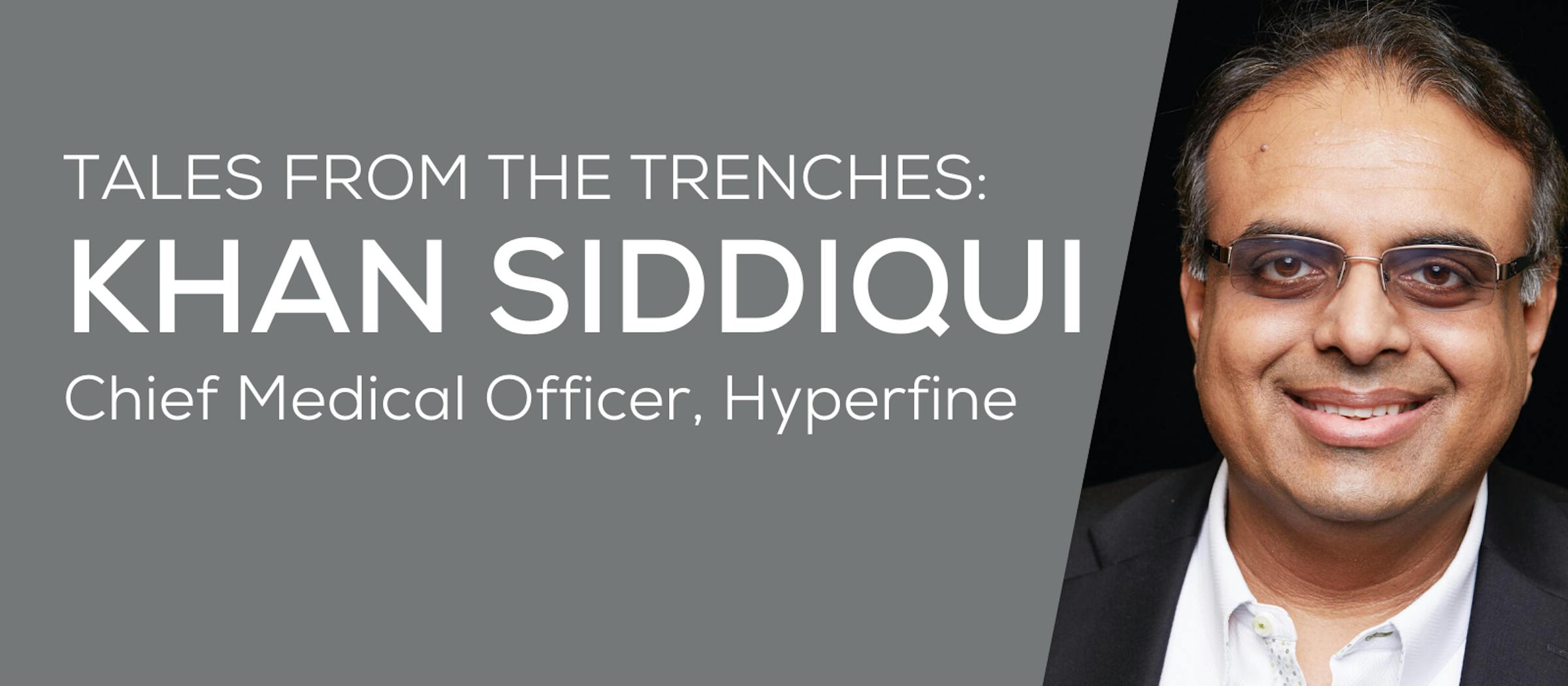Serial entrepreneur and radiologist Khan Siddiqui shares his journey and keys to innovative thinking at Tales from the Trenches
Once a curious kid in a small town in Pakistan, now a leader at the forefront of healthcare innovation, Khan Siddiqui lives by the notion that if you’re not failing, you’re not trying hard enough.
Having spent his career solving some of healthcare’s biggest challenges, Khan always starts with the problem, not the solution. With this mindset, he went on to create several successful health tech startups. Khan founded Higi in 2012, a population health company that empowers people to measure, track and act on their health numbers easily through self-screening stations at over 11,000 retail locations. Today his latest venture is Hyperfine: the world’s first portable and point of care magnetic resonance (MR) device, inspired by the idea to decentralize MR and make it more patient centric.
In a conversation moderated by VillageMD Co-founder and Chief Strategy Officer Paul Martino, Khan Siddiqui discussed his self-proclaimed atypical journey to medicine and entrepreneurship, the importance of innovation and the inspiration behind two of his most successful ventures.
Here are our key takeaways from that discussion. Responses have been edited slightly for length and clarity.
An upbringing filled with inspiration and curiosity
“My journey has been very unorthodox and atypical. I grew up in a small town in Pakistan and had very inspirational parents, both physicians, who motivated me early on to think about becoming a physician. My father was a trained hand surgeon, oncological surgeon and radiologist. As a result, I got exposure to radiation oncology equipment when I was very young. The first program I wrote was on a PDP-11 for a nuclear medicine gamma camera in sixth grade.
“Since I was a kid, I’ve always worked on problems — never going into it thinking that it’s going to be a business idea or an opportunity. The first problem someone asked me to solve was to build an exam management system for a medical school in Pakistan in the late 1980s… that system ultimately became my first software to get acquired. At the time, I didn’t think I was selling a company or becoming an entrepreneur, but in hindsight, that’s exactly what was happening.
“Since I was a kid, I’ve always worked on problems — never going into it thinking that it’s going to be a business idea or an opportunity.”
“My exposure to medical schools while building that software and having two strong physician role models at home fueled my fascination for medicine. I started at medical school in 1990, being the only medical student that knew how to code. Fortunately for me, key events were happening in parallel at that time that would allow for me to flourish…For example, the Centers for Disease Control and Prevention (CDC) chose Aga Khan University in Karachi, Pakistan as the level five infectious disease center hub for all of Southeast Asia. One of the 35 CDC employees that came to Pakistan to establish the center was looking for help with open source statistics, which I happened to be experienced in. And then they found me. I ended up writing some of the code to do linear regression modeling and machine learning for disease prediction in the early 1990s. We applied that to the health system, and eventually used it to run economic analysis to predict the cost of burden at the time of patient admission.”
“After I graduated in 1998, I moved to the U.S. to do my residency at New York University Grossman School of Medicine and immediately got sucked into health IT. Then, in 1999, I moved to Geisinger Medical Center for my radiology training and became involved in picture archiving and communication system (PACS) implementation. We were one of the first sites that implemented standard PACS, which became Philips and went on to be very successful.”
The makings of a serial health tech entrepreneur
“Initially in my career, my goal really was to stay in academics. Early on, all of my work focused on pediatric, cardiac and fetal cardiac MR research.
“As time went on, I started thinking about a different career path. With the help of my wife, I realized how much time I spent on clinical research — yet there were maybe five people in the world who would even read what I was writing. Yet, I would spend 10 minutes in an IT meeting, and the entire health system would be talking about my work. That’s when I really stepped back and asked myself why I was resisting a career in informatics.”
“At the time, there were some medical informatics training programs around the U.S., but nothing in imaging. So, I started calling around. Then, I had one fruitful call with Dr. Eliot Siegel, the chair at the Baltimore VA and vice chair at the University of Maryland, and convinced him to start an imaging informatics fellowship program. He told me, ‘I’ll do it, if you come start it.’
“After successfully starting and running the country’s first imaging informatics fellowship program, I went to Microsoft, where I managed the execution of medical imaging across all of their healthcare product portfolio. During my last year at Microsoft, I was responsible for building some of the strategy and consumer health around our attempt at a web-based personal health record system, HealthVault, and got interested in where personal healthcare needed to go. After meeting some very interesting people, I ended up coming to Chicago to build Higi.”
The inspiration behind Higi
“The idea for Higi came in 2012. As I was thinking about how to get millions of people engaged in their health, my future colleagues at Merrick Ventures in Chicago were thinking similarly. In a value-based care system, we know that most of the risk data is sitting in between care episodes. What a patient is doing during their daily life contributes more to their risk than what happens during their care episode.
“When thinking through how to capture the data that exists between care episodes, we focused on cardiovascular diseases, obesity and diabetes. These conditions occur most commonly in elderly and low income populations. Knowing that we have to meet patients where they are in order to fully engage, we came up with the idea of deploying kiosks in grocery stores and pharmacies to understand the cardiovascular, obesity and diabetes risks of patients.”
“At the time, everyone said it was a crazy idea and that kiosks belonged in the 1980s. But, we knew our population would engage more on their turf than in acute care settings. Today, Higi has over 10,000 stations deployed and is the largest kiosk network in the country through amazing partnerships with payers, providers and health systems, and we are still growing. What made Higi successful was focusing on meeting patients in the moment to get them more engaged with and responsible for their health.”
“What made Higi successful was focusing on meeting patients in the moment to get them more engaged with and responsible for their health.”
“With Hyperfine, my latest venture, we remain focused on patient centric care. The idea is to take MR to the patient’s bedside, bringing scanning to them. The company’s mission is to decentralize MR and make it more patient centric.”
The art of innovation
“To me, having an innovative team starts at the top. If you want to innovate, your entire organization has to maintain a culture of innovation. People can’t be afraid of trying and failing; it is on leadership to not only tolerate, but to encourage experimentation and failure so that people are not afraid to get penalized for trying new ideas.”
“People can’t be afraid of trying and failing; it is on leadership to not only tolerate, but to encourage experimentation and failure so that people are not afraid to get penalized for trying new ideas.”
“The entire reason I joined Hyperfine is because of the team. It has taken five years and a lot of partnerships with academics to get Hyperfine to where it is. Together, we tackle one problem at a time. It’s been fascinating to see how everyone on the team has contributed and innovated.
“Ideas never really evolve solely from one person’s brain - usually it’s a collection of prior experiences that build up to one innovative solution. Sometimes, ideas stay in somebody’s brain for decades and slowly, with experience and time, they start to formulate. Innovation never happens in a eureka moment, but rather at a slower pace, over time.
“For me, three things must be true for innovation to be successful.
“First, you must be married to the problem, not the idea. You have to be focused on a problem that people care about, and you have to be willing to pivot. Innovation is about trying, trying and then trying again.
“Second, good timing and optimal product market fit are crucial. Sometimes, an idea just comes too early.
“Third, you must have an innovative team. It’s very rare for a sole individual to be truly innovative. It’s much easier to build an out-of-the-box thinking team than it is to find an out-of-the-box thinker. People with different experiences and thought processes can innovate faster, together.”
Preventative care needs to become the new normal
“If we want to see our health system change, deliver and live up to the promise of taking care of our citizens, we must think about the preventative aspect of healthcare.”
“As Americans, we tend to think of our future selves as some other person. For example, we operate with the mindset that eating healthy today will only benefit someone 10 years down the road; in our brains we associate ourselves today and ourselves 10 years from now as two different people.
“Language contributes to that significantly. In the English language, we have words for yesterday, today and tomorrow. In some other languages, such as Chinese and Mandarin, the word for yesterday, today and tomorrow is the same. Research shows that the more associated tenses are, the less you see yourself in the future as the same person. If you look at that data, you’ll see that greater instances of obesity, diabetes and hypertension are in the cultures whose languages associate tenses.
“The question is: How do we help people understand, from a patient point of view, that it is you that is going to get healthier? And what is the short term benefit to get patients to that mindset?
“The key is to make healthy behaviors a normative influence. The dialogue that happens between the patient and the health system needs to switch to a normative influence of preventative care. Once prevention is the norm, we will see acceleration in that division of care.”
“The key is to make healthy behaviors a normative influence. The dialogue that happens between the patient and the health system needs to switch to a normative influence of preventative care. Once prevention is the norm, we will see acceleration in that division of care.”
Want to watch the full interview? Visit our live events page.



